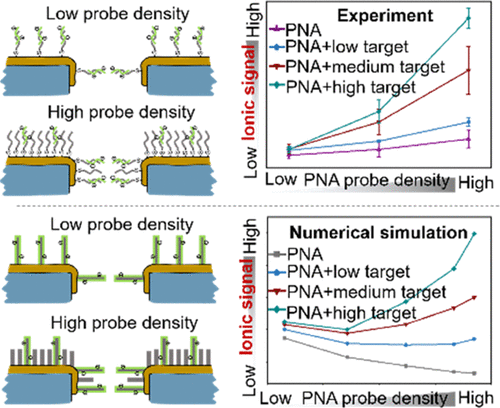当前位置:
X-MOL 学术
›
Anal. Chem.
›
论文详情
Our official English website, www.x-mol.net, welcomes your feedback! (Note: you will need to create a separate account there.)
Revealing Ionic Signal Enhancement with Probe Grafting Density on the Outer Surface of Nanochannels
Analytical Chemistry ( IF 6.7 ) Pub Date : 2021-09-14 , DOI: 10.1021/acs.analchem.1c03010 Tianle Liu 1 , Xiaoqing Wu 1 , Hongquan Xu 1 , Qun Ma 1 , Qiujiao Du 2 , Quan Yuan 3 , Pengcheng Gao 1 , Fan Xia 1
Analytical Chemistry ( IF 6.7 ) Pub Date : 2021-09-14 , DOI: 10.1021/acs.analchem.1c03010 Tianle Liu 1 , Xiaoqing Wu 1 , Hongquan Xu 1 , Qun Ma 1 , Qiujiao Du 2 , Quan Yuan 3 , Pengcheng Gao 1 , Fan Xia 1
Affiliation

|
Probe-modified nanopores/nanochannels are one of the most advanced sensors because the probes interact strongly with ions and targets in nanoconfinement and create a sensitive and selective ionic signal. Recently, ionic signals have been demonstrated to be sensitive to the probe–target interaction on the outer surface of nanopores/nanochannels, which can offer more open space for target recognition and signal conversion than nanoconfined cavities. To enhance the ionic signal, we investigated the effect of grafting density, a critical parameter of the sensing interface, of the probe on the outer surface of nanochannels on the change rate of the ionic signal before and after target recognition (β). Electroneutral peptide nucleic acids and negatively charged DNA are selected as probes and targets, respectively. The experimental results showed that when adding the same number of targets, the β value increased with the probe grafting density on the outer surface. A theoretical model with clearly defined physical properties of each probe and target has been established. Numerical simulations suggest that the decrease of the background current and the aggregation of targets at the mouth of nanochannels with increasing probe grafting density contribute to this enhancement. This work reveals the signal mechanism of probe–target recognition on the outer surface of nanochannels and suggests a general approach to the nanochannel/nanopore design leading to sensitivity improvement on the basis of relatively good selectivity.
中文翻译:

揭示纳米通道外表面探针嫁接密度的离子信号增强
探针修饰的纳米孔/纳米通道是最先进的传感器之一,因为探针与纳米限制中的离子和目标强烈相互作用,并产生敏感和选择性的离子信号。最近,离子信号已被证明对纳米孔/纳米通道外表面上的探针-目标相互作用敏感,这可以为目标识别和信号转换提供比纳米限制腔更多的开放空间。为了增强离子信号,我们研究了纳米通道外表面上探针的接枝密度(传感界面的关键参数)对目标识别前后离子信号变化率的影响(β)。分别选择电中性肽核酸和带负电荷的 DNA 作为探针和靶标。实验结果表明,当加入相同数量的靶标时,β值随外表面探针接枝密度的增加而增加。已经建立了具有明确定义的每个探针和目标的物理特性的理论模型。数值模拟表明,随着探针接枝密度的增加,背景电流的减少和纳米通道口处目标的聚集有助于这种增强。这项工作揭示了纳米通道外表面探针-靶标识别的信号机制,并提出了纳米通道/纳米孔设计的通用方法,从而在相对良好的选择性的基础上提高了灵敏度。已经建立了具有明确定义的每个探针和目标的物理特性的理论模型。数值模拟表明,随着探针接枝密度的增加,背景电流的减少和纳米通道口处目标的聚集有助于这种增强。这项工作揭示了纳米通道外表面探针-靶标识别的信号机制,并提出了纳米通道/纳米孔设计的通用方法,从而在相对良好的选择性的基础上提高了灵敏度。已经建立了具有明确定义的每个探针和目标的物理特性的理论模型。数值模拟表明,随着探针接枝密度的增加,背景电流的减少和纳米通道口处目标的聚集有助于这种增强。这项工作揭示了纳米通道外表面探针-靶标识别的信号机制,并提出了纳米通道/纳米孔设计的通用方法,从而在相对良好的选择性的基础上提高了灵敏度。
更新日期:2021-09-28
中文翻译:

揭示纳米通道外表面探针嫁接密度的离子信号增强
探针修饰的纳米孔/纳米通道是最先进的传感器之一,因为探针与纳米限制中的离子和目标强烈相互作用,并产生敏感和选择性的离子信号。最近,离子信号已被证明对纳米孔/纳米通道外表面上的探针-目标相互作用敏感,这可以为目标识别和信号转换提供比纳米限制腔更多的开放空间。为了增强离子信号,我们研究了纳米通道外表面上探针的接枝密度(传感界面的关键参数)对目标识别前后离子信号变化率的影响(β)。分别选择电中性肽核酸和带负电荷的 DNA 作为探针和靶标。实验结果表明,当加入相同数量的靶标时,β值随外表面探针接枝密度的增加而增加。已经建立了具有明确定义的每个探针和目标的物理特性的理论模型。数值模拟表明,随着探针接枝密度的增加,背景电流的减少和纳米通道口处目标的聚集有助于这种增强。这项工作揭示了纳米通道外表面探针-靶标识别的信号机制,并提出了纳米通道/纳米孔设计的通用方法,从而在相对良好的选择性的基础上提高了灵敏度。已经建立了具有明确定义的每个探针和目标的物理特性的理论模型。数值模拟表明,随着探针接枝密度的增加,背景电流的减少和纳米通道口处目标的聚集有助于这种增强。这项工作揭示了纳米通道外表面探针-靶标识别的信号机制,并提出了纳米通道/纳米孔设计的通用方法,从而在相对良好的选择性的基础上提高了灵敏度。已经建立了具有明确定义的每个探针和目标的物理特性的理论模型。数值模拟表明,随着探针接枝密度的增加,背景电流的减少和纳米通道口处目标的聚集有助于这种增强。这项工作揭示了纳米通道外表面探针-靶标识别的信号机制,并提出了纳米通道/纳米孔设计的通用方法,从而在相对良好的选择性的基础上提高了灵敏度。






































 京公网安备 11010802027423号
京公网安备 11010802027423号